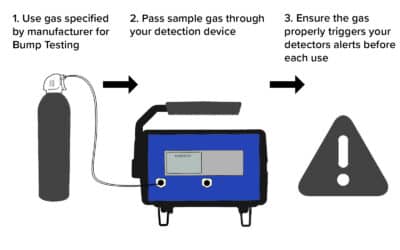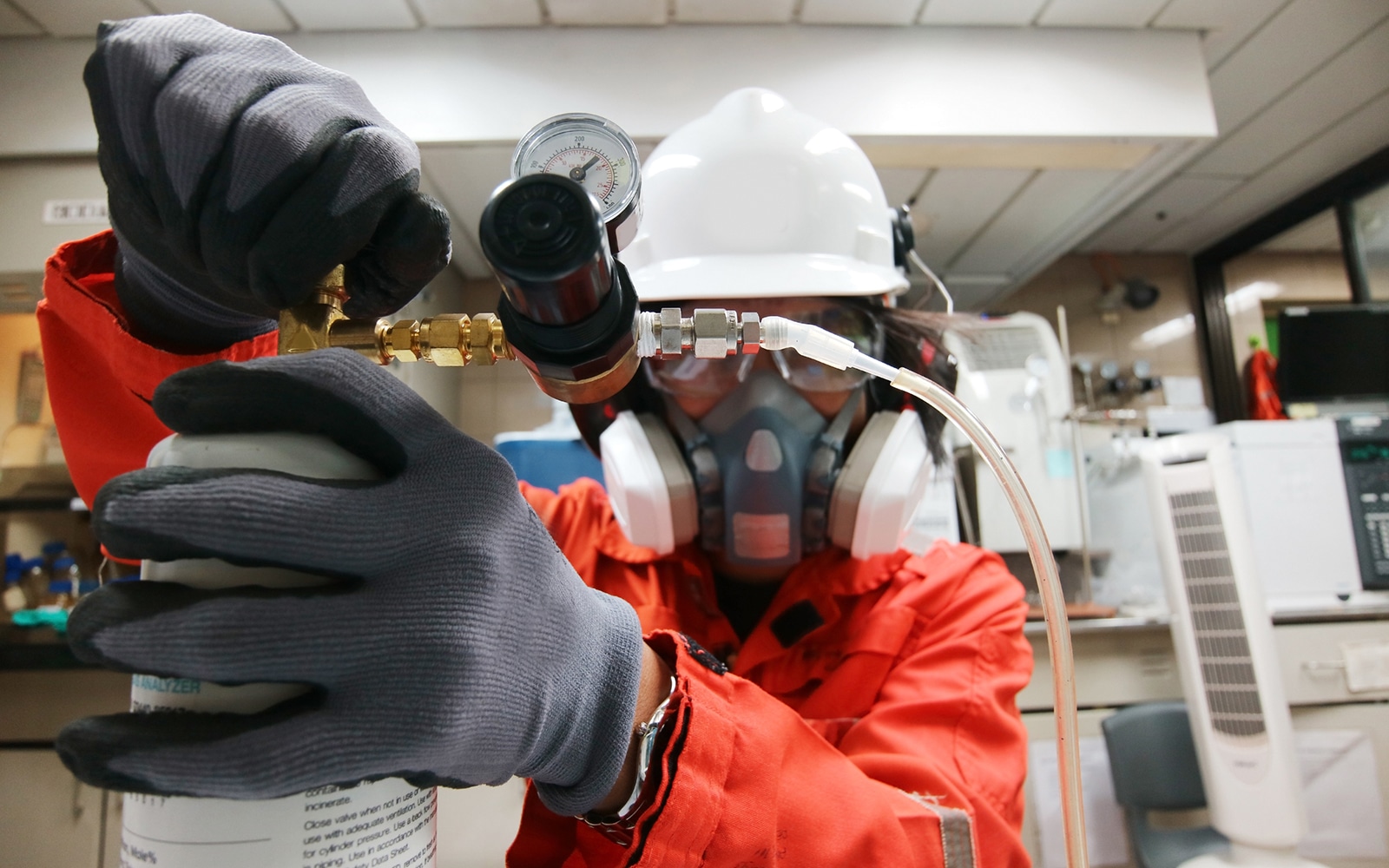- Bump testing is a check that the gas detector is working.
- Bump testing before each use ensures worker safety.
- The procedure requires only a few seconds and minimal costs for the test gases.
A gas detector that doesn’t work can be life-threatening. Bump testing ensures that all functions of the device are working correctly. Performing quick and regular maintenance checks, such as bump testing the device, is essential for proper gas detector use. Find out more about bump testing and how to conduct it.
What is a Bump Test?
The Bump Test is also called Function Check. According to the Occupational Safety and Health Administration (OSHA), a bump test is a qualitative check to show that the sensors and the instrument alarms are functional. In the test, the challenge gas is passed over the gas detectors in amounts higher than the minimum to be tested by each sensor. The test checks that the gas detector can pick up the gas and respond through its alarms, which can be audio, visual, or both.
The bump test does not check the device’s accuracy, only functionality. Device calibration, a quantitative test, is necessary to check device accuracy.
If the gas detector works properly, the alarms will go off and alert you to the gas tested.
If the gas detector’s alarms do not work during a bump test, do not deploy the device to the workplace. Send the device immediately for troubleshooting. The device must then be calibrated to check its accuracy before using it again. If the instrument fails full calibration, remove the gas detector from service. In these cases, contact the manufacturer or supplier for assistance.
Bump testing is a crucial aspect of the gas detection procedure, and no detector should be deployed before ensuring that the instrument is working.
Training users in bump testing is essential to gas detector use, and the training should be repeated until the workforce is confident in its practice.
Bump testing could also be known as Response/Challenge Testing.
Why is Bump Testing Necessary?
There are many reasons why your gas detector may not work correctly.
Gas detectors are used in demanding circumstances where conditions can be rugged. The devices could be exposed to hot and humid environments, dust, moisture, and sludge/mud, which can clog the device filters and block gas, so the device can’t sense gas in further tests.
Gas detectors could also be dropped in the workplace, leading to dislodging of the sensors.
Any one of these causes can significantly affect the gas device’s performance. A bump test before use is; therefore, critical to be sure that the gas detectors work in the moment of need.
Whether a gas detector functions or not, it reads zero for toxic gases in clean air. The only way to know the device is working is by bump testing it.
How to Conduct a Bump Test?

To find out which gases to use for testing the gas detector, consult the manufacturer’s instruction manual.
A bump test is considered to be successful and the device safe for use if the following two conditions are fulfilled:
- The gas readings should be within 10% of the concentration of the test gas mentioned on the cylinder.
- The audio and visual alarms should be heard and seen within 30 seconds of exposure.
If the device fails either test, it must be checked and calibrated before use.
During a bump test, when the device is exposed to the gas it is meant to test, usually, as toxic gas concentrations rise, oxygen concentrations will decrease. Individual gas detectors or a four-gas monitor should sense all these changes, provide readings, and set off the alarms.
After the test, the gas is turned off, and the gas detector stabilizes. The oxygen reading should return to 20.9%, and all other gases should be zero ppm (parts per million), percent by volume, or percent of LEL (lower explosive limit). If the values do not return to zero, try stabilizing the device in clean air.
The entire test takes less than half a minute.
If a gas detector fails a bump test, consult the manufacturer’s instruction manual to determine the next steps.
There are two main methods by which bump testing can be conducted. One is manual, and the other is by using a docking station.
Manual Test
Check the manufacturer’s instructions and follow the steps recommended for a bump test.
A manual bump test requires a gas bottle, tubing, a regulator, and a calibration/test cap. Ensure that the gas bottle has not expired and has the correct concentration for the test.
The usual steps are as follows:
- Attach the tubing to the regulator and screw the regulator to the gas bottle, which is initially closed.
- Attach the calibration cap to the device and turn on the bump test mode.
- Now turn on the gas bottle to release the gas and check the gas detector readings and alarms.
- Once the test is over, turn off the gas bottle and detach the cap from the device.
Another method of manual bump test is to apply the gas to the instrument while the main reading screen is on. Here no calibration cap is used. The bump tests are successful if the sensor shows readings and the alarms work. Conduct these bump tests in a room with good ventilation or outside if toxic gases like CO or H2S are being tested so that the personnel are not affected.
The disadvantage of manual bump testing is that people may forget to conduct it before use. Using docking stations eliminates that challenge since workers must leave their instruments on the station after use.
How Often Should You Bump Test Gas Detectors?
Every gas detector must be bump tested and calibrated after delivery and before the first use since the device could get damaged during transport.
After that, the frequency of bump tests depends on the use. The rule is that the device goes through bump testing before each use.
If the gas detectors are used daily, they should be bump tested daily before use in the morning. If another person subsequently uses the instrument, the instrument must be bump-tested again by them.
If gas detectors are used once a week, the bump test is also conducted once a week before use.
If the worker is going into confined spaces, an additional bump test before entry is recommended.
Contact Supplier or Manufacturer
Bump tests can save lives! It will be necessary to buy the gas for bump tests, but it is money well spent. The cost of gas used for each bump test is meager. The benefits of saving lives or preventing injury far outweigh these minimal bump testing costs. Contact your gas detector supplier or manufacturer if you need further clarification about how to conduct bump tests.
Written by:
Vijayalaxmi Kinhal
Science Writer, CID Bio-Science
Ph.D. Ecology and Environmental Science, B.Sc Agriculture
Source
Matei, K. B. (2021, Oct, 6). 6 Important Questions About Bump Testing Your Gas Detector. Retrieved from
https://www.safeopedia.com/6-important-questions-about-bump-testing-your-gas-detector/2/7528
OSHA. (2013). Calibrating and Testing Direct-Reading Portable Gas Monitors. Retrieved from https://www.osha.gov/publications/shib093013

